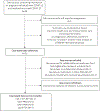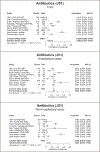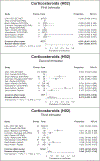How COVID-19 Treatment in Pregnancy Reflects Healthcare Utilization During a Pandemic: A Two-Stage Individual Participant Data Meta-Analysis Combining Case-Based Registries
- PMID: 40665803
- PMCID: PMC12418691
- DOI: 10.1002/pds.70180
How COVID-19 Treatment in Pregnancy Reflects Healthcare Utilization During a Pandemic: A Two-Stage Individual Participant Data Meta-Analysis Combining Case-Based Registries
Abstract
Purpose: To describe an international response to the COVID-19 pandemic by estimating the prevalence of medication use for COVID-19 treatment in pregnancy, stratified by hospitalization, trimester of pregnancy, and country.
Methods: We conducted a two-stage individual participant data meta-analysis of proportions from primary data on medications used to treat COVID-19 during pregnancy. A common data model was developed to pool the data from single-country and international registries. Data from pregnant individuals with COVID-19 between February 2020 and October 2022 were included in study platforms across 9 data sources. Patient information was abstracted from medical records.
Results: Among 24 937 pregnant individuals, the pooled prevalences of individuals receiving medications to treat COVID-19 were: 34.7% heparin, 9.8% antibiotics, 4.9% corticosteroids, 2.2% antivirals, 0.8% antimalarials, 0.3% convalescent plasma, 0.2% immunosuppressants, and 0.02% monoclonal antibodies. Prevalence of medication use was higher in hospitalized individuals than in non-hospitalized individuals: 58.4% versus 17.9% for heparin, 26.9% versus 5.7% for antibiotics, 17.5% versus 1.3% for corticosteroids, 10.3% versus 0.3% for antivirals, and 4.5% versus 0.1% for antimalarials. The prevalence of corticosteroid use was lower in the first trimester (0.1%) compared with the second (7.2%) and third (4.9%) trimesters of pregnancy. The prevalence of medications differed widely across countries.
Conclusion: Medication to treat COVID-19 was more frequently used in pregnant individuals hospitalized for COVID-19. Corticosteroids were used less in the first trimester of pregnancy. The differences in use between countries could reflect differences in the clinical management and access to medications for this population at risk of severe disease.
Keywords: CONSIGN group; COVID‐19; medication use; meta‐analysis; pregnancy.
© 2025 John Wiley & Sons Ltd.
Conflict of interest statement
Conflicts of Interest
Begoña Martinez de Tejada received consultancy fees from Exeltis and Effik about medication for nausea and vomiting during pregnancy. All other authors declare no conflicts of interest.
Figures




References
-
- NIH, “COVID-19 Treatment Guidelines Panel,” Coronavirus Disease 2019 (COVID-19) Treatment Guidelines. National Institutes of Health; —28 December 2022. 28.12.2022 (2022), https://files.covid19treatmentguidelines.nih.gov/guidelines/archive/covi.... - PubMed
Publication types
MeSH terms
Substances
Grants and funding
LinkOut - more resources
Full Text Sources
Medical

